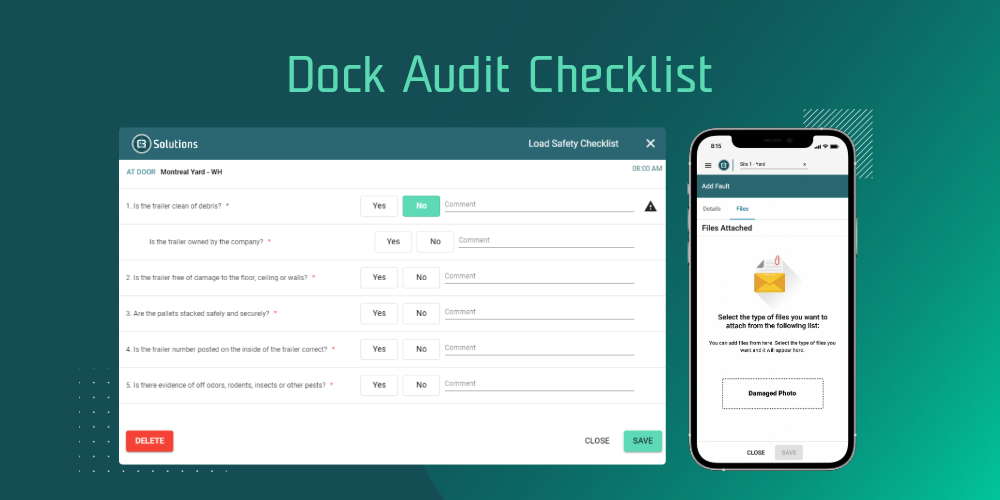How to conduct a dock audit on inbound deliveries?

Modern warehouses are larger than ever, powerhouses of efficient operations that handle thousands of shipments daily.
Every minute and every transaction counts, and maintaining tight control of inbound dock deliveries for the first time right is crucial.
This can be handled by setting up a control and monitoring mechanism through audits.
This article explores different aspects of conducting audits on inbound dock deliveries, discussing the what, why, and how, including challenges and the future outlook.
But first, let us understand what dock audit is.
What is a dock audit, and why is it important?
A dock audit is the systematic review and inspection of goods received at the warehouse dock.
It verifies product types, quantities, and conditions against details on the purchase orders or shipping documentation.
This audit ensures that what was ordered is what is being received, both in quality and quantity, thereby safeguarding inventory accuracy and operational integrity.
Dock audit is a critical element of overall logistics integrity. Without it, frequent mismatches will lead to delays and cost escalations.

The goal of a dock audit
The primary objective of a dock audit is to ensure accuracy, compliance, and quality in the receiving process.
By meticulously matching received goods with purchase orders, dock audits help identify discrepancies early, prevent costly inventory errors, enhance supplier accountability, and ensure the quality of goods entering the supply chain.
Audits have become critical in today's logistics, where many shipments are moved through a hub-and-spoke model.
An error at one node can then quickly move to the next, multiplying the error in the network.
Challenges of dock audits
Conducting a thorough dock audit is not easy in modern warehouses, and it comes with its set of challenges:
-
Matching the volume velocity:
The sheer volume of goods and the speed at which they must be processed can strain audit accuracy. Large docks handle hundreds of shipments daily. The magnitude of these operations presents a significant challenge in maintaining a high level of accuracy in dock audits. Minor errors multiplied across numerous transactions can lead to substantial discrepancies. Audits cannot be the reason for delays. The detention costs are between $50-$100 per hour and will impact the logistics costs for the customers.
-
Supplier Discrepancies:
Variances in supplier documentation and actual shipments can create reconciliation headaches. Suppliers from different regions often have varying documentation standards, making it difficult for audit teams to verify the accuracy of shipments.
-
Resource Allocation:
Allocating sufficient staff and technological resources to audits without impeding operational flow is often challenging.
-
Data Management:
Dock audits involve vast and complex data, encompassing shipment details, supplier records, inventory levels, and more. Efficiently managing and analyzing audit data for actionable insights requires sophisticated systems.
The challenges we discussed underscore the need for a strategic approach to dock audits that balances operational efficiency with the thoroughness of inspections.
Companies are now turning to technology solutions that offer automation and advanced data analytics to address these challenges.
For example, leveraging AI to predict and prioritize high-risk shipments for audit based on historical data can significantly enhance audit efficiency.
Similarly, integrating dock scheduling systems with ERP and WMS systems can help the warehouse manager understand the upcoming flow of shipments and prepare the teams in advance.
How to conduct a dock audit?
While there are challenges in auditing incoming shipments, implementing a formal approach to dock audits can mitigate these challenges, ensuring efficiency and accuracy. Here's a 6-step process for conducting a focused and effective audit:
-
Advance Preparation: Establish clear audit criteria based on company policies, purchase orders, and compliance requirements. This audit criteria will be the foundation and guide the audit process and decision-making. This can be a list of different parameters that need to be checked for the shipments.
-
Technology Integration: Utilize advanced dock scheduling and audit software like C3 Solutions' Audit Module, which enables real-time visibility, automated discrepancy alerts, and comprehensive data analysis, making the audit process faster, more insightful, and more accurate.
-
Sampling: In high-volume environments, auditing every item might not be feasible. Adopt a statistical sampling method to inspect a representative subset, ensuring coverage without overwhelming resources.
-
Training: Equip your audit team with the necessary skills and tech knowledge to conduct effective audits. This includes training on audit software, inspection techniques, and company-specific compliance requirements.
-
Procedure Standardization: Develop standardized audit procedures to ensure consistency across all audits. This includes checklists, reporting formats, and escalation protocols for discrepancies.
-
Data Analysis: Leverage audit findings to identify trends, supplier performance issues, or systemic weaknesses in the receiving process. Analytical insights can drive continuous improvement and supplier negotiations.
While these six steps serve as a good reference framework, companies can build and customize their own frameworks aligned to their needs.
While these frameworks help build a structure for the audits, the teams conducting them should also be sufficiently trained. Let us understand this next.
Training Dock Audit Teams
The effectiveness of audits hinges not only on the technologies they employ but also on the team's adeptness in utilizing these tools and audit goals. This emphasizes the importance of continuous training and development programs tailored for dock audit teams. Below, we discuss key components for enhancing the skill set of your audit team:
-
Regulatory Updates:
The dock must get regular updates on the latest compliance requirements. This becomes critical for docks receiving international shipments as the regulatory requirements and documentation can differ. Internal compliance officers or external legal experts specializing in supply chain logistics can help share such updates or conduct regular sessions.
-
Root-cause analysis:
Analyze past instances of non-compliance, discussing the repercussions and the lessons learned. This helps teach a proactive compliance mindset among audit team members.
-
Technology Familiarization Workshops:
Workshops on new technologies integrated into the dock scheduling and audit systems should be planned. These could cover topics ranging from the basics of operation to advanced troubleshooting and optimization techniques.
-
Simulation-Based Learning:
Utilize simulations and virtual training environments to help team members understand the applications of AI, machine learning, and IoT in real-world auditing scenarios. This hands-on approach can significantly improve their comfort and proficiency with these technologies.
By investing in the training and development of dock audit teams, companies can significantly enhance the effectiveness of their audit processes.
This ensures compliance and safety and contributes to optimizing dock operations, ultimately leading to improved efficiency, cost savings, and higher customer satisfaction.
Enhancing Inbound Dock Delivery Audits with C3 Solutions
We discussed the complexity and criticality of conducting effective audits on inbound dock deliveries.
This is often overlooked but must be one of the focus areas for compliance and effectively driving operations.
Integrating smart technologies and solutions like C3 Solutions' Audit Module is instrumental in facing these challenges.
By leveraging advanced data analytics, real-time tracking, and comprehensive reporting features, businesses can streamline their audit processes and transform their inbound logistics operations into a benchmark of accuracy, efficiency, and compliance.
All these factors will improve customer satisfaction and NPS scores.
Dive into the future of dock audits with C3 Solutions and redefine what's possible in your logistics and supply chain operations. Reach out today to discuss your business needs.



